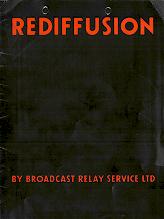Carlton House, Lower Regent Street
London SW1. Tel. Whitehall 0221-30
BROADCAST RELAY SERVICE LIMITED
Associated Companies in over 175 towns in Great Britain and in Barbados, Bermuda. Canada, Ceylon, Guyana,
Hong Kong, Jamaica, Malaya, Malta, Singapore, South Africa, Trinidad and West Africa etc.
© rediffusion.info 2010
Explaining the System of Transmitting Broadcast Programmes By Wire. BROADCAST RELAY SERVICE LTD 1941
 |
A Modern Rediffusion Plastic Loudspeaker |
|
 |
Receiving Station and Control Equipment. |
|
 |
Typical Network Distribution Schematic. |
|
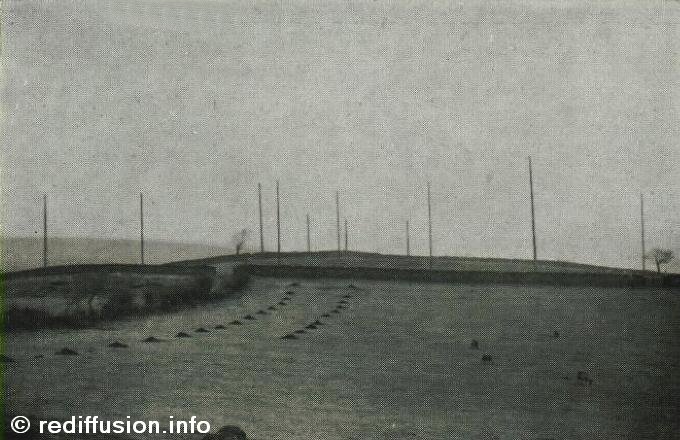 |
Aerial Receiving Station. South Wales |
|
 |
Overhead Feeder Wires. |
|
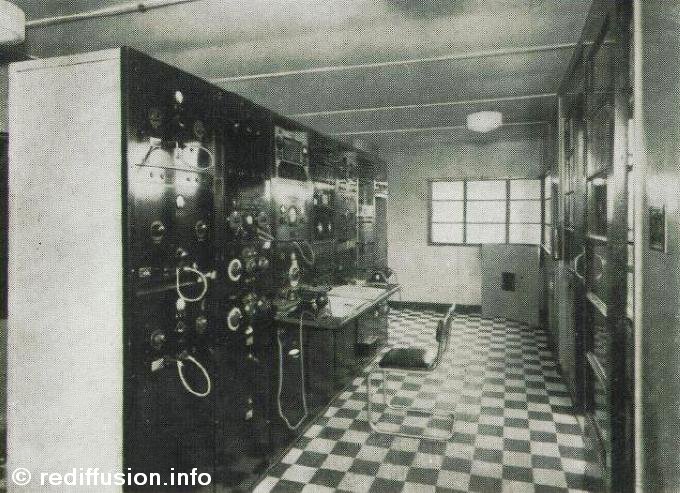 |
Receiving Panel |
|
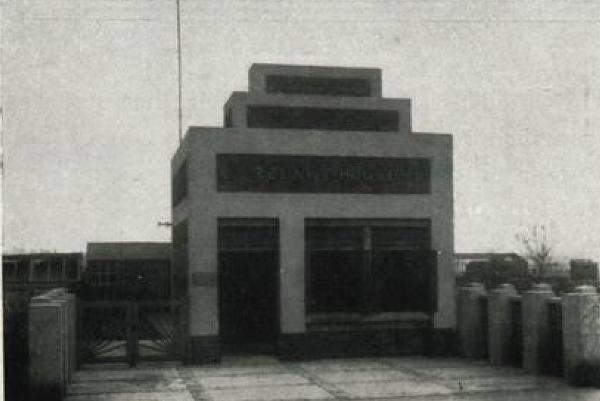 |
Broadcast Relay Substation. Hull |
|
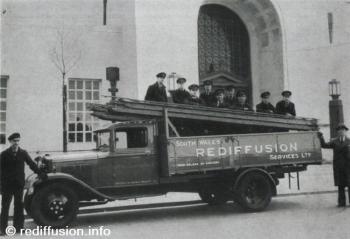 |
Network Wiring Crew |
|
What is Rediffusion
Rediffusion is the name given by Broadcast Relay Service Ltd to its system of distributing broadcast programmes.
The programmes are carried by wire to listeners who subscribe to the service operated by local subsidary companies in many Centres of Great Britain and Overseas.
It is known that. By December 1946 nearly 750.000 homes in the United Kingdom received their broadcast programmes by wired systems.
That number is continuously and rapidly increasing. During the twelve months ending March 1946, the companies associated with Broadcast Relay Service Ltd, who are by far the largest relay service operators, increased the number of their subscribers by more than 22%.
What are the advantages explaining the rise in popularity of this modern method of reception?
Quality.
The first and most obvious advantage is the very high quality of reception. When broadcast programmes are bought from the studio to the listeners by wire, instead of the ordinary wireless transmission, interference, fading and distortion are eliminated. These annoyances, so familiar to listeners by the older method, disappear altogether
Neither weather conditions nor geographical situation, nor "man made static" due to trolley busses or other electrical machinery can affect the broadcast programme carried by wire and there is no risk of interference from unwanted programmes broadcast on a nearby waveband.
Every listener to a wireless set knows the irritation of that occasional persistent background of music when he is listening to talk, or of a talk when he is trying to listen to music. It compels him to turn the tuning knob and although this may get rid of the interference, it narrows at the same time the frequency band of the programme to which he is listening, thus further distorting the quality of the voice or instruments he wants to hear. No such choice between quality and freedom from interference has to be made by the Rediffusion listener. Reception by wire gives programmes quite free from distortion and it gives them without background noise of any kind.
Simplicity.
The second great advantage of Rediffusion is its extreme simplicity. The subscriber has no aerial or receiving set to worry about, no valves or batteries to wear out, no need of electric current to operate the set. A loudspeaker with a volume control and a switch is all that is required.
The chosen programmes are available instantly on switching on, there is no waiting for valves to warm up.
Economy.
Rediffusion is most economical. The subscriber receives a free loudspeaker on loan and the service is connected to his home on payment of a small connection charge. A low weekly rental covers all service and maintenance charges. If required, more elaborate loudspeakers can be supplied and the subscriber can have as many rooms wired in his house as he requires. This permits programmes in different rooms with maximum economy of operation.
Service.
Rediffusion is a service. The weekly rental covers complete and free maintenance and engineers are always available to deal with faults should they arise. The company collects the weekly rentals through its collection staff, saving the subscribers much trouble.
The company is constantly striving for improvements in its standards of service. It maintains a central research laboratory to study and
experiment in the technique of wired transmission. In this new science of broadcast reception, fresh developments are constantly arising and
Broadcast Relay Service Limited keeps abreast of them in the interest of its subscribers. This work has enabled many communities in Britain
to enjoy Rediffusion, particularly the long valleys of South Wales where small compact communities are served from control centres many miles
away from them.
This question of service is of special importance to local authorities who may be considering the institution of a wired broadcasting system
in their areas. Large capital resources and very considerable technical knowledge and experience are needed for the planning and development of such a system on sound lines. It is emphatically not a job that any " practical wireman " can do and if subsequent disappointment is to be avoided, it should be entrusted only to a firm which can show the necessary qualification and which is able to give the necessary undertaking to develop the service so that will be brought within the teach of the whole local community.
Rediffusion cannot, of course provide an unlimited number of programmes. The radio enthusiast who wishes to tune in to programmes from all over the world must have a complicated multi-vaIve set to meet his needs, but very often he has Rediffusion as well on account of its supreme quality.
From long practical experience of putting their service into Rediffusion service into many thousands of homes, Broadcast Relay Service Limited know that the very large majority of people listen regularly to the same programmes and occasionally to other broadcasts on special occasions. It in also known that listening habits are changing and that increasing importance in being paid to the interest value of programmes rather than their source. Therefore, more and more attention is being focused on real quality of reproduction and the ability to hear every word and note as clearly as it would be heard in the studio itself. Rediffusion is the perfect means of broadcast reception for this large majority, because at gives the programmes they require with complete reliability, maximum economy and minimum trouble.
It offers broadcast entertainment "laid-on" in the home like the other essential services of gas, water and electricity.
How Rediffusion Works.
The system developed by Broadcast Relay Service Limited during the past fifteen years has been based on a policy of decentralisation.
Operating Companies are made as self supporting as possible and are almost entirely run by personnel drawn from the area. The value of this policy of decentralisation was most strikingly revealed during the war in the case of one of the company's overseas services, Malta, G C. where the service continued without a break through all the worst of the enemy's attacks though effective contact with Head Office in London was very limited. On the other hand, local and overseas companies associated with Broadcast Relay Service Limited are able to call upon the powerful resources of the parent company which include central research, planning, purchasing and other technical and commercial facilities.
The company also controls its subsidiary factory at Wandsworth, London where the highly specialised amplifiers and equipment are made for the Rediffusion Service.
During the fifteen years in which Broadcast Relay Service has operated, the Company has had practical experience in the operation of both
radio and audio frequency Rediffusion systems, and has carried out extensive research on every type of relay system.
The Company's present general use of its own highly developed audio frequency system is the direct outcome of certain proof that this type of
system gives its listeners the most reliable and efficient service, with the purest reproduction and the absolute minimum of equipment.
Audio frequency systems do not require any electricity for their operation, which allows B.R.S. Rediffusion to be installed in any household.
The Programme Input.
The focal point in the system of. each operating company is the Central Control Station, established as near as possible to the centre of the area to be served. Special buildings are erected in many cases to house the Central Control. A Receiving Station is established at a point outside the built up area, where reception conditions have been proved by test to be as good as are obtainable, and here the aerial array is erected, usually including directional aerials of various kinds and specially designed Rediffusion receiving sets are installed to cover all broadcast wavebands.
The Central Control can receive programme inputs from varying sources. Programmes can be carried direct from the broadcasting studios to Central Control by land line, from which point distribution takes place over the Rediffusion network. The Rediffusion Receiving Station is equipped with special high fidelity receivers and aerials. Often individual receivers and aerials are pre-tuned to receive one special broadcasting station. The programme inputs from broadcasting stations are then relayed by land line to Central Control.
From Central Control To Subscriber.
At Central Control the programmes received are monitored, amplified and passed on to subscribers. They may go direct to nearby subscribers over the Company's own line called a " Service Feeder," or they may be passed on over low-level links, ie., telephone lines if available, or private lines erected by the Company, to sub-amplifer stations, from which other service feeders radiate. Thirdly, they may be carried on high-level links to distant transformer kiosks, where the voltage is stepped down to service level, and from which again other service
feeders bear them to their destination in hundreds of private homes. Whichever method is employed and usually all are employed simultaneously, Central Control is in complete charge of every programme at every stage. The operator on duty there can monitor not only all
incoming programmes from any source, but also the output from each sub-station and each kiosk in his area. Thus he knows just what each
subscriber is receiving, and he has on call a staff of technicians ready to deal with any emergency that may arise.
The Feeder Network.
The system of planning and wiring a Feeder Network to serve many thousands of subscribers in a large town is too technical to describe in
detail here. It has been the subject of elaborate study by the technical experts of Broadcast Relay Service Limited in the light of their unrivalled
experience. Much of the wiring for Rediffusion is overhead wiring and there is a natural tendency to fear that overhead wiring may injure the
amenities of a district. Badly planned and badly erected wire may certainly disfigure a town and there is always a danger that this may happen if the work is put in the wrong hands. But experience proves that Rediffusion wiring, subject to certain important conditions, need have no injurious effects whatever.
Service And Rental Charges.
As already stated, the service rental for domestic installations is made on a weekly basis, with a small initial charge for connection.
Together the rental and connection charge cover the cost of bringing the wire to the subscribers house and of connecting up at the point chosen by the subscriber. The provision (on loan) of a well designed moving coil loudspeaker with a programme switch and volume control and
regular inspection and maintenance of the wiring and equipment.
The programme input giving a choice of programmes throughout the normal hours of broadcasting with perfect reception.
The subscriber can have as many rooms in the house wired for Rediffusion as he wishes. A small installation charge is made for each point which, when fitted with a standard programme selector switch, contributes a valuable feature to the Rediffusion service, ie. that the individual subscriber can have different programmes in different rooms. However many separate programme inputs form the Rediffusion service,
the subscriber can naturally have the same number of different programmes in different rooms. This cannot be accomplished by one wireless set, a separate set must be used for each programme to be received.
Rediffusion And The Local Community.
The part Rediffusion has come to play in the life of the community in which it operates may be illustrated by a few statistics. It is only about eighteen years since Rediffusion began and six of those were years of war. Yet in certain towns it has already attained a density of more than fifty per cent. That is to say, every other house, or rather more than that, receives its broadcast programmes through the service provided by the local operating company of Broadcast Relay Service Limited. Densities of one house in three are fairly common. In one single town more than 32,000 homes subscribe to the Rediffusion Service, in another, more than 25,000. These figures are rapidly rising, as rapidly as supplies of labour and materials will permit new subscribers to be connected to the service.
There could hardly be more striking evidence of the value private citizens attach to the existence of a Rediffusion Service in their locality. This is not all. The Rediffusion Service is particularly well adapted to the needs of; hospitals, schools, young peoples clubs, hotels, and similar institutions, and the Company is prepared to wire such buildings, and to provide the necessary loudspeakers, on advantageous terms. Factories are also wired for intercommunication and for " Music While You Work.” Rediffusion is also particularly well equipped for the installation of broadcast reception equipment in Hotels, where loudspeakers can be provided in individual bedrooms, so that guests may enjoy radio programmes in their own rooms.
Hotels can also be wired for guest and staff-location systems, and by the Rediffusion method the whole system is, at all times, under the direct
control of the management.
Employment Of Local Labour.
It is the policy of Rediffusion to employ local labour. The Company formed to operate the service in any area draws its staff almost entirely
from that area. Two or three specially skilled executive staff such as the Manager, Engineer or Foreman, have to be imported, so that their
years of experience and special training with Rediffusion shall be available in the training and direction of the local staff. The staff required
comprises wiremen, operators, clerks, salesmen, collectors, typists, etc.
Agreement With The Local Authority.
The Rediffusion system operates under a general agreement with the Government Authority. An agreement with the Local Authority
grants the necessary permission for the operation of a Rediffusion system in its area, and also grants permission for the erection of the feeder
network in the area which is under its control. Safeguards are always included to provide that all wiring shall be carried out to the satisfaction
of the Local Authority. ln return for the permission granted by the Local Authority, the Company undertakes to give a service to be available to the inhabitants of a given area at a weekly rental.
CO-OPERATION WITH LOCAL BUSINESS
It is the policy of Rediffusion to co-operate with local businesses, Some parts of the specialised equipment required for Rediffusion systems
have to be made in Rediffusion's main factory, but wherever possible, arrangements would be made for the local manufacture and purchase of
equipment. Thus, providing that suitable supplies are available, poles, masts, aerial towers, etc., can be obtained locally. Buildings, if required,
are erected by local contractors. The Company is a large user of electricity, and the Rediffusion Service uses electric power from the local mains. Receiving and control stations, sub-amplifying stations, etc., take a constant steady load from the mains during hours of broadcasting. Owing to its good power and high load factors, this consumption is most welcome by electricity companies. The Company also rents telephone lines for the interconnection of its stations where suitable lines of this type are available.
There are many other local businesses that benefit by the Cornpany's activities, such as printers, newspapers, etc.
Broadcast Relay Service Limited And Its Associated Companies.
Broadcast Relay Service is a public company with an issued capital of over £1,500,000 and combined resources of over £3,000,000. It is the parent of thirty subsidiary operating companies, through which a Rediffusion service is provided in the following places in the United Kingdom and Overseas:
Abertillery. Bangor, Bargoed, Bedwellty, Gellygaer, Mynyddislwyn. Barrow, Askam, Dalton. Blackpool, Thornton Cleveleys. Bristol.
Broadstalrs. Cwmcarn. Dartlington. Exeter. Fleetwood. Gateshead, Blaydon, Felling, Whickham. Hull, Cottingharn. Kendal. Lancaster.
London. Maidstone. Margate. Merthyr, Vaynor. Morcombe. Newcastle, Gosforth. Newport, Caerleon. Nottingham, Arnold, Beeston, Carlton, West Bridgeford. Plymouth, Saltash, Torpoint. Pontypridd, Caerphilly. Pontypool. Ramsgate. Rhondda, Llantrisant, Llantwit, Fardre. Rochdale, Milnrow, Prestwich, Wardle, Whitefield, Whitworth. Rotherham, Rawmarsh. St. Helens, Haycock. South Shields, Boldon, Hebburn, Jarrow. Stretford. Sunderland. Swansea. Tynemouth, North Shields. Wallasey. Wallsend. Whitley Bay. Wolverhampton.
Malta G.C. Trinidad. W.I.
* The London operating company provides a special service in many large blocks of Flats and big London Hotels.
Planning And Equipment.
It must be emphasised that very considerable capital is required to develop, on sound lines, a Rediffusion Service in a new area.
Experience has shown that unless the central organisation and service network for a town are correctly and efficiently planned at the outset,
a very unsatisfactory service may result and unless the necessary capital is then available, development will be retarded or even stopped
in the early stages, so that the service fails to come within reach of the majority of the local population for whom it is intended.
These dangers do not arise if the task is entrusted to a company with the resources of Broadcast Relay Service Limited behind it. Nor should
these resources be thought of only in terms of money. Expert knowledge and experience are of at least equal importance. The technical services available to the operating subsidiaries of Broadcast Relay Service Limited are grouped together in another subsidiary company known as Central Rediffusion Services Limited. This company maintains Design and Planning Departments, the Research Laboratories, and central departments for the purchase and testing of equipment. Much of the specialised equipment, including amplifiers, transformers, receiving sets is made in factories controlled by the parent Company through its manufacturing subsidiary, Reditiusion Limited (Wandsworth), which has been largely engaged throughout the war, and since, on the production of highly technical communications equipment for the Government, the Service Departments, and commercial users all over the world.
Conclusion.
Broadcast Relay Service Limited is fully equipped in every way to undertake the development of a Rediffusion Service in any new
area. The Company has: The capital resources to install and develop the system in the most efficient way.
The experience to ensure that the service is built and maintained on the most modern lines.
The technical resources to overcome peculiar local difficulties and to make the most of local advantages.
The skilled manpower to plan and establish the service network with full regard for local amenities.
The research organisation to give the Company and its subscribers full benefit of the latest developments in the technique of Rediffusion.
The Company invites full inquiry as to its ability to meet all these requirements. Its established systems in any or all of the places listed are open to inspection by representatives of local authorities or by other responsible persons interested in the development of a Rediffusion Service.
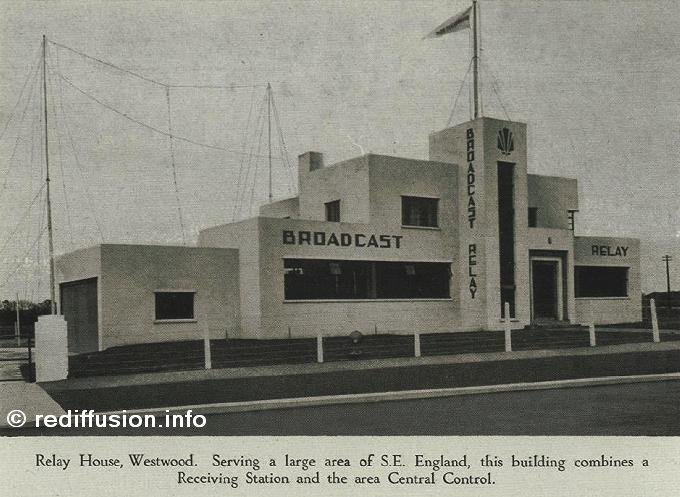 |
Westwood House. Thanet, Kent. |
|
The following text is a re-production of a Promotional Booklet produced by Broadcast Relay Service in 1941 outlining the merits of their wired sound system.
The BRS Booklet
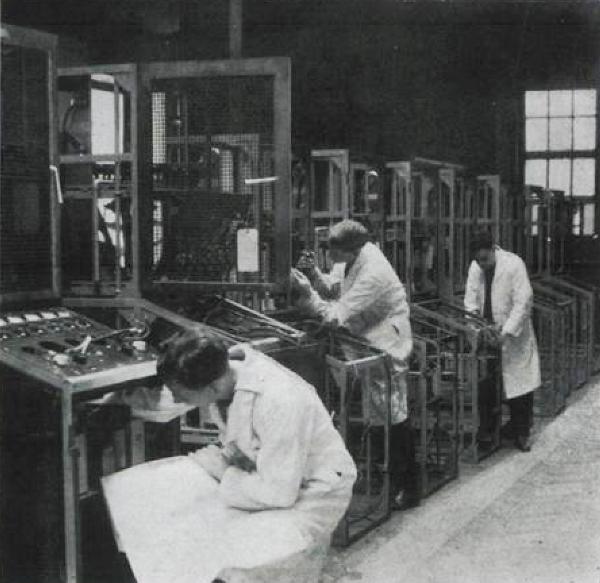 |
Equipment Assembly. Wandsworth London. |
|
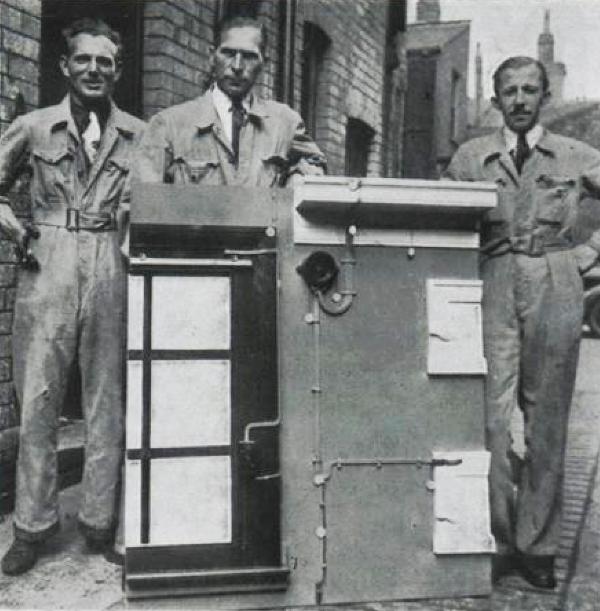 |
Wiring Models. |
|
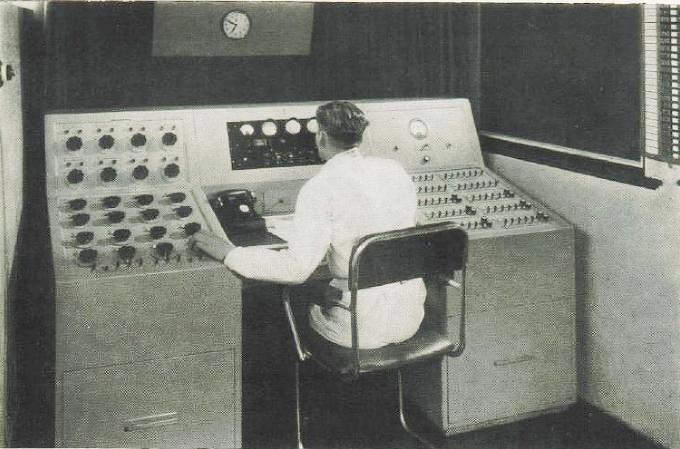 |
Control Desk |
|
 |
Tyneside Receiving Station. |
|





